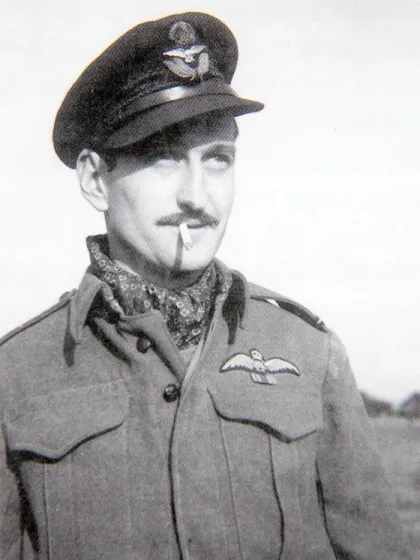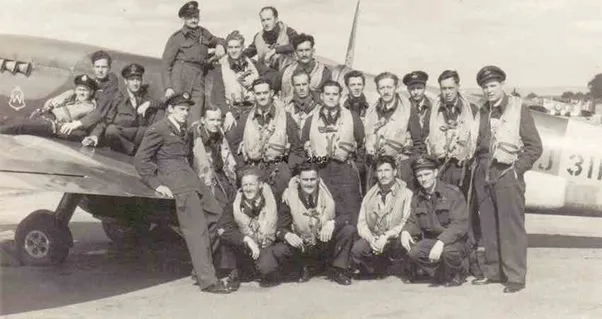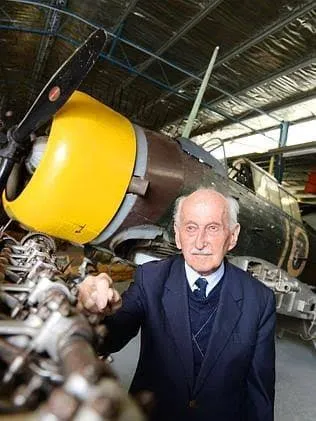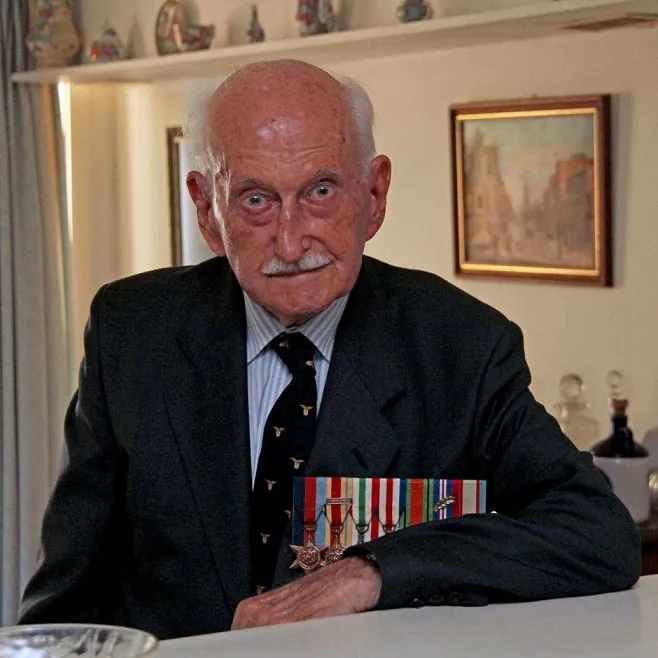FLTLT Murray Adams 400613
MiD



| Squadron/s | 80 SQN RAF 250 SQN RAF |
| Rank On Discharge/Death | Flight Lieutenant (FLTLT) |
| Mustering / Specialisation | Pilot |
| Date of Birth | 15 Jul 1919 |
Murray was born on 15 Jul 1919 at Hawthorne, VIC
To hear Murray Adams talk about his life as a World War II fighter pilot is to revisit a time when extraordinary luck was a blessing and unflinching bravery a common commodity.
The understated way he recounts his tale of cool-headed survival following a north African dogfight in December 1941 is inspirational and humbling.
Whether speaking of aerial combat over Tunisia or dive-bombing tanks in the Italian Alps, the 94-year-old recalls his experiences with clarity and enthusiasm.
Mr Adams joined the Royal Australian Air Force (RAAF) in 1940 after war broke out, despite not knowing how to fly.
He was still inexperienced when pulled off a training course and posted to the Royal Air Force's (RAF) 250 Squadron in the Libyan desert.
It was during an intense battle with German fighters over the desert that Mr Adams's Tomahawk sustained shrapnel damage.
"The Germans had vastly superior speed and rate of climb," said Mr Adams.
"They were always on top of us and instead of coming down and mixing with us, they just made dirty darts from a great height.
"Coming down at such a high speed, the controls are fairly well frozen so all you had to do was kick on the rudder and watch them (the Germans) go past.
"Of course, they'd shoot while they had the chance to," he said.
His fighter sustained shrapnel damage during the battle and he found himself in an inverted spin with the desert approaching rapidly.
"We didn't really know how to get a Tomahawk out of a spin in those days," he cheerfully explained.
"Luckily I was at 14,000 feet and spinning so I thought that the best thing to do was to get out of this airplane."
But a bullet had pierced the aircraft's canopy, making it impossible for him to slide open. At the same time, the cockpit was filling with warm oil which was swirling about the canopy, blocking his vision.
"Just about then, the engine seized up because most of the oil was in the cockpit and the thing came out of a spin by itself, about 200 feet from the ground.
"So, I just did a belly landing," he said calmly.
Unfortunately, his problems were far from over. He was lost in the desert with no food or water and when a convoy of German trucks approached, his only cover was to lie flat and still on the sand.
"I walked a bit further and thirst was becoming a bit of a problem," he said.
"There was another plume of dust and I thought, 'I'm going to take this one, whatever colour their stripes are'.
"It happened to be a British major with his driver, so as nonchalantly as possible I said, 'can you give me a lift, old chap?"
Now Mr Adams is the chairman of the RAF's Escaping Society Australian chapter and also a member of The Late Arrivals Club, whose motto is, "It's never too late to come back".
He is very nonchalant about his near-death experience. "It's not brave. It's just survival". When you went in, you knew what the risks were. It was just a job," he said.
I was back flying in four days".
During his WWII flying career, Mr Adams flew a range of aircraft in missions over Italy, the Mediterranean, Western Europe and Britain.
"I did more flying on Spitfires than any other type," said Mr Adams.
"It was everybody's favourite aircraft because it was so good to fly, responsive to the controls and so on.
This volunteering was a joke. It was all part of the game.
"But the Tempest had extra speed and armament and I would have to rank it as being certainly the best aircraft I ever flew."
Mr Adams counts leading 34 aircraft across France after D-Day in a show of strength as one of the highlights of his aviation career.
He also proudly claims to have never passed an air force medical, despite doing high-altitude flying.
Flying a specially modified Spitfire in 1943, Mr Adams flew to 45,000 feet without pressure or radio.
At the same time, German reconnaissance aircraft, pressurised and with diesel engines, were reaching 50,000 feet.
"We thought if we could get close enough to put one hole through the cabin, the sudden reduction of pressure would put the crew out of action," recalled Mr Adams.
"It was rather good up there. The map of Italy and Greece was laid out like an atlas. The sky was a dark purple and you could see the curvature of the earth. "You didn't volunteer for that mission. This volunteering was a joke. It was all part of the game. I was told to do it, and you automatically obeyed. "Log book is a reminder.
Mr Adams finished his tour in 1945 as a Flight Lieutenant and now lives in Brisbane.
His log book, covered in a goat skin purchased in a Khartoum market, records every single mission and aircraft he flew during the war.
On his 89th birthday, he took a tandem parachute jump and enjoyed it immensely.
At the robust age of 94, Mr Adams travelled from Brisbane to the Australian National Aviation Museum, to see Wirraway A20-10; an aircraft he flew in 1941. A war planes enthusiast had told him it was in Moorabbin.
He didn’t know how to fly when he joined the air force, but after "a bit of luck getting in” he was soon soaring over the Victorian countryside in training in the Wirraway.
Mr Adams remembered the cheeky detour he took on his last flight during training when he "buzzed” his home town, flying only about 50 feet above market goers.
"I was very naughty and if I’d been caught then that would have been the end of my flying days,” he said.
"But I found my father riding on a horse and threw out a small note on a parachute which I'd prepared the day before telling him to get down to the police station and stop them from reporting it."
Mr Adams flew in Hurricanes, Gladiators, Tomahawks and Kittyhawks in North Africa during the war years and was shot down once.
It was exciting, but the young pilot wanted to fly the faster, more powerful Spitfires, and soon his chance came.
"I ran into a an old flight commander late one night in a nightclub in Alexandria and we got to talking.
"He happened to be in charge of a squadron of Spitfires and when I asked him what I had to do, he just said it would happen.
And before he knew it he was flying Spitfires and Tempests over Italy and the rest of Europe.
"It was incredibly exciting," he said.
See Murray in the Temora Aviation Museum "Unsung Heroes" Project, here: Flight Lieutenant (FLTLT) Murray Adams - Unsung Heroes.


